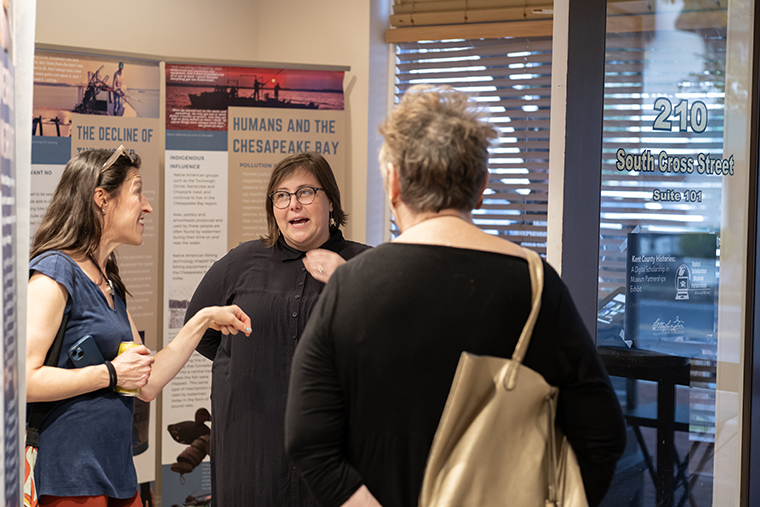College Opens New Exhibit Space Downtown
Visitors can tour five regional museums through virtual reality at Washington College’s first exhibit, which features the work of the Digital Scholarship in Museum Partnerships project.

Education professor Sara Clarke-De Reza talks with attendees of a First Friday in the College's new exhibit space at 210 South Cross Street.
Washington College's Center for Environment & Society (CES) and the Digital Scholarship in Museum Partnerships (DSMP) project are proud to invite local and regional visitors to virtually “tour” the collections from several regional museums, all in one place. Housed in the community space that CES leases at 210 South Cross Street in downtown Chestertown, the exhibit includes interactive exhibit banners from the DSMP's collaborations with Kent County museums over the last six years, including Betterton Heritage Museum, the Worton Point Schoolhouse, the Waterman's Museum, the Kent Museum, and Sumner Hall. Visitors can check out digitized collections and learn about the unique cultural heritage of the Eastern Shore.
With the goal of preserving and providing greater access to the local histories of our community, the exhibit offers digitized looks into each museum viewable through virtual reality with 360-degree virtual tours of the museums, a look at digitized collections from each site, oral history interviews, and more. The exhibit also features a new curved projection theatre which creates an immersive environment in which to experience the virtual tours.
The panels were created by Washington College students participating in the DSMP project and serve as a continuation of their work, which was curated under the guidance of Sara Clarke-De Reza, associate professor of education and director of the museum, field, and community education minor; Julie Markin, professor of anthropology and director of archaeology; and Raven Bishop, assistant director of educational technology and lead of the Virtual/Augmented Reality Digital Imaging Studio (VARDIS) at the Miller Library. After a successful one-day pop-up showcase of the project last fall, an opportunity to put the work on display for a longer period, and for a wider public audience, emerged at the Cross Street space.
“Working with these museums affords our students the opportunity to apply concepts and best practices learned in the classroom to a project that makes a real impact for the local community,” said Bishop. “Students and community stakeholders are immediately able to see the real-world impact of this work as it improves access to the history and culture of Kent County within and beyond our community.”
Bishop added that community partners often report that their organizations feel reinvigorated by the energy and enthusiasm that DSMP students bring to the project. The reciprocal relationship advances the common purpose of providing greater access to the important cultural heritage of the Eastern Shore that is held in so many small, rural community museums.
“It would be easy to say that the technology is the most interesting part of this project,” said Bishop. “But what is most exciting about this project is the way students are able to authentically contribute to a community-engaged digital scholarship project with real-world impact. Bringing students off of the Washington College campus and into meaningful partnership with community members is one of the most important goals of our work. Students benefit from feeling a stronger connection to place and feel good knowing that they can contribute to Kent County in a small way.”
The exhibit is located at 210 South Cross Street and is open to the public through January on the First Fridays of each month from 5:00 to 8:00 p.m., as well as every Saturday from 9:00 to 11:00 a.m. The collections may also be viewed by appointment. Scanning the QR codes on the exhibit's exterior windows will allow access to digital versions of the exhibit even when the space is closed.